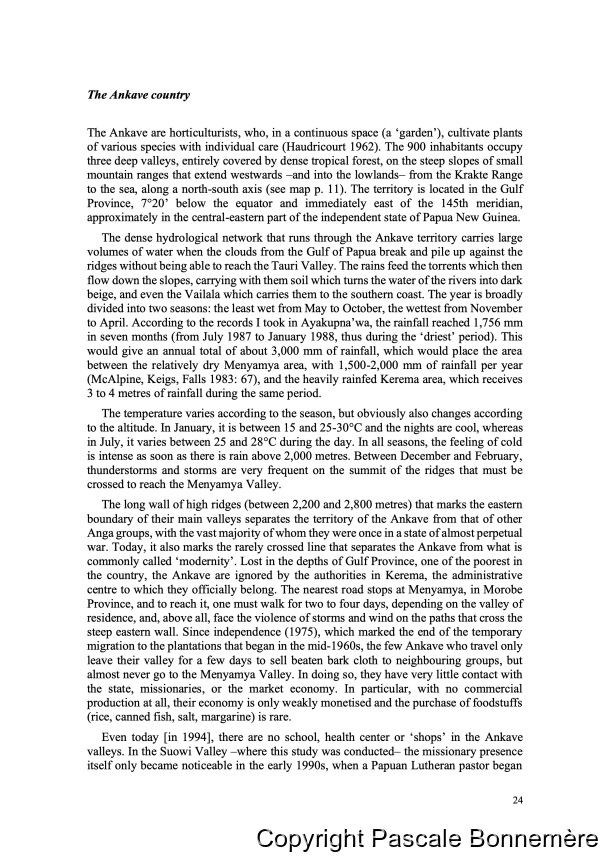|
|  [Note: this transcription was produced by an automatic OCR engine]
The Ankave country
The Ankave are horticulturists, who, in a continuous space (a ‘garden’), cultivate plants
of various species with individual care (Haudricourt 1962). The 900 inhabitants occupy
three deep valleys, entirely covered by dense tropical forest, on the steep slopes of small
mountain ranges that extend westwards —-and into the lowlands- from the Krakte Range
to the sea, along a north-south axis (see map p. 11). The territory 1s located in the Gulf
Province, 7°20° below the equator and immediately east of the 14Sth meridian,
approximately in the central-eastern part of the independent state of Papua New Guinea.
The dense hydrological network that runs through the Ankave territory carries large
volumes of water when the clouds from the Gulf of Papua break and pile up against the
ridges without being able to reach the Tauri Valley. The rains feed the torrents which then
flow down the slopes, carrying with them soil which turns the water of the rivers into dark
beige, and even the Vailala which carries them to the southern coast. The year is broadly
divided into two seasons: the least wet from May to October, the wettest from November
to April. According to the records I took in Ayakupna”’wa, the rainfall reached 1,756 mm
in seven months (from July 1987 to January 1988, thus during the ‘driest” period). This
would give an annual total of about 3,000 mm of rainfall, which would place the area
between the relatively dry Menyamya area, with 1,500-2,000 mm of rainfall per year
(McAlpine, Keigs, Falls 1983: 67), and the heavily rainfed Kerema area, which receives
3 to 4 metres of rainfall during the same period.
The temperature varies according to the season, but obviously also changes according
to the altitude. In January, it is between 15 and 25-30°C and the nights are cool, whereas
in July, it varies between 25 and 28°C during the day. In all seasons, the feeling of cold
is intense as soon as there is rain above 2,000 metres. Between December and February,
thunderstorms and storms are very frequent on the summit of the ridges that must be
crossed to reach the Menyamya Valley.
The long wall of high ridges (between 2,200 and 2,800 metres) that marks the eastern
boundary of their main valleys separates the territory of the Ankave from that of other
Anga groups, With the vast majority of whom they were once in a state of almost perpetual
war. Today, it also marks the rarely crossed line that separates the Ankave from what is
commonly called ‘modernity’. Lost in the depths of Gulf Province, one of the poorest in
the country, the Ankave are ignored by the authorities in Kerema, the administrative
centre to which they officially belong. The nearest road stops at Menyamya, in Morobe
Province, and to reach it, one must walk for two to four days, depending on the valley of
residence, and, above all, face the violence of storms and wind on the paths that cross the
steep eastern wall. Since independence (1975), which marked the end of the temporary
migration to the plantations that began in the mid-1960s, the few Ankave who travel only
leave their valley for a few days to sell beaten bark cloth to neighbouring groups, but
almost never go to the Menyamya Valley. In doing so, they have very little contact with
the state, missionaries, or the market economy. In particular, with no commercial
production at all, their economy is only weakly monetised and the purchase of foodstuffs
(rice, canned fish, salt, margarine) is rare.
Even today [in 1994], there are no school, health center or ‘shops’ in the Ankave
valleys. In the Suowi Valley -where this study was conducted the missionary presence
itself only became noticeable in the early 1990s, when a Papuan Lutheran pastor began
24
�
|